December 11, 2007 at 10:00 pm · Filed under FAQs, Mobile technology
We have been only partially successful at avoiding Emma’s cold. Eleanor has a mild congestion, and I have a sore throat. Nobody feels 100% but at least we are mostly functional. But because we are dragging ourselves along and the days are so short at this time of year, it seems almost impossible to get anything done before sunset.
This morning we meandered out of our campsite on the shore of the Colorado River in Needles, and puttered further along Rt 95 in the desert, eventually merging with I-10 south of Joshua Tree National Park. We had no fixed destination in mind. Along the way, we tried entering Joshua Tree from the south side, but the only campground in the park (Cottonwood, 4000 ft. elevation) was cold and windy and lonely. The ranger station was closed for staff training, there were no evening ranger programs within 30 miles, and I couldn’t blog or do any work up there since there was no cellular service. If we’d planned a couple of days in advance we might have stayed, but for an impulsive visit it didn’t make sense. We decided to skip Joshua Tree in favor of the warmer air down in the Palm Springs area.
I think the virus is affecting our decisions. With a rhinovirus in your system, you want warmth and comfort food. You want plenty of hot water and early bedtime. You want a movie or a book in bed. You don’t want to go rock-hopping at 4000 ft. in a cold breeze 40 miles from the nearest pharmacy. Our adventuresome instincts have been blunted by the influence of a microscopic nuisance.
However, this is an opportunity to talk about ways to avoid microscopic nuisances. (You’ll admire the smoothness of this segue in a moment.) Last week at REI I bought a Steripen, which is a little hand-held ultraviolet light that renders harmless all bugs that might be in your drinking water. You press a button, dip the light into the water, and in about 90 seconds it has scrambled the DNA of 99.999% of the viruses, bacteria, and protozoa in the water. Voila! Safe drinking water.
UV devices like this are commonly built in to household water treatment systems, but this portable version is ideal for an RV’er. It runs on 4 AA batteries and it weighs less than a pound. I bought it after a lot of research into ways to get safe water when traveling in Mexico. Filters can get out the “chunky” stuff like metals, chemicals, protozoa, and bacteria (down to about .9 microns), but they can miss some bacteria and all the viruses. (For example, hepatitis can be caused by contaminated water.)
So-called “purifiers” can knock out the viruses but they generally do that by introducing chemicals like iodine or chlorine. I like my water to contain only water. So I chose a two-step approach: fill the fresh water tank with well-filtered water, then treat it with the Steripen for drinking purposes.
We use the Camco CX90 ceramic in-line filter on our fresh water hose whenever we fill the tank or are connecting to city water. This ensures the water in our tank and fixtures is not contaminated by sediment, etc., and it also improves the taste.
The system works. Las Vegas water tastes horrible, but with the CX90 and the charcoal filter built-in to our Moen kitchen faucet, it was passable. I’m planning to use the Steripen when we go to Mexico next, and here in the USA it is also useful for those times when we are boondocking and need to make safe drinking water from the fresh water holding tank.
Tonight the blog comes to you from the parking lot at the Spotlight 29 Casino in Coachella CA, right at the noisy intersection of I-10 and 86. We’re here with eight other RVs, laying low until sunrise, when we can get back on the road down toward the Salton Sea.
December 10, 2007 at 11:45 pm · Filed under Uncategorized
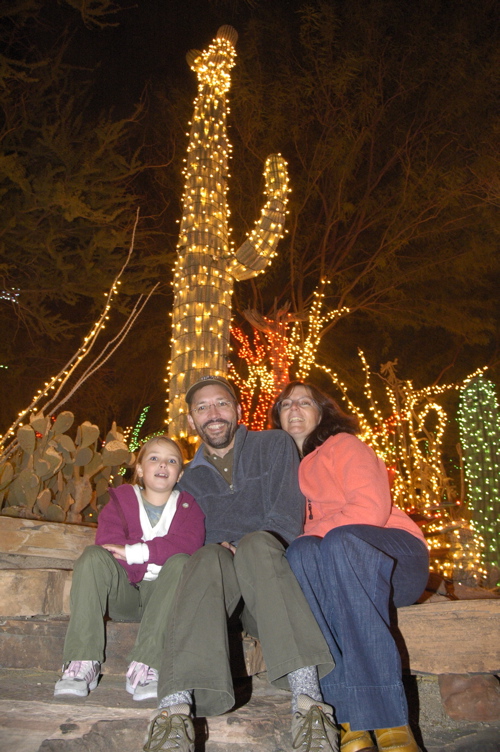
Our visit with Brian and Leigh has been one of the most successful courtesy parking episodes ever. We set a record for driveway parking: six nights. Normally we’re gone in a day or two, but this time we had nowhere in particular to go and lots of reason to stay.
Today we finally hitched up and pulled out, with the general intent of cruising Route 93 south toward Needles. But first we headed up to North Las Vegas to get a wash at the Blue Beacon Truck Wash. The trailer has been desperately dirty for weeks, to the point that I hate to even walk near it. A light-brown film covers every surface, and streaks of brownish goo drip down the side when there’s condensation. This always seems to happen to us when we drive through the Los Angeles area.
This time we totally struck out on the truck wash. There was a line of 10 big rigs ahead of us at the wash, which meant a wait time of over an hour. We backed out into the street (Eleanor jumped out of the truck to help me back up without crashing into traffic) and headed south in the fast-waning sun. We didn’t exactly shine.
OK, when you hear of Needles, California, what do you think of? Be honest. Do you think of Spike, Snoopy’s brother who lived out in the desert near Needles? Do you think of that line in the song “Never Been To Spain” by Three Dog Night?
Well I never been to England
But I kinda like the Beatles
Well, I headed for Las Vegas
Only made it out to Needles
It’s one of those towns that has a vague identity for easterners, even though we’ve all heard of it. Historic Route 66 runs through town but there’s not a lot of impact from that. Needles isn’t close to much (except the gambling town of Laughlin, NV, on the other side of the Colorado River). It’s just a quiet spot along the Colorado River, a place to go waterskiing in the desert.
One thing is for sure, you don’t think of low gas prices here. As an outpost, it has exceptionally expensive fuel. Regular unleaded in town runs $3.85 for the cash-only place and $3.89-4.09 everywhere else. We bought ten gallons and will fill up completely in Palm Springs.
December 9, 2007 at 11:29 pm · Filed under Places to go
There really is nothing like Las Vegas. Love it or hate it, it’s unique. And since Brian and Leigh haven’t kicked us out yet, we finally got a chance to go scout around town with them today.
Our first stop was the Las Vegas sign on Las Vegas Boulevard at the north end of The Strip. Leigh is building a collection of photos of everyone who has stayed overnight at their house. Each visitor is posed in front of the Las Vegas sign. I’ve been wanting to be the subject of one of those photos ever since I saw the first one on their blog months ago. The sign is a popular spot, despite being located in the median strip of a busy road. There’s always someone there getting their picture taken. So now we are part of our hosts’ permanent history.
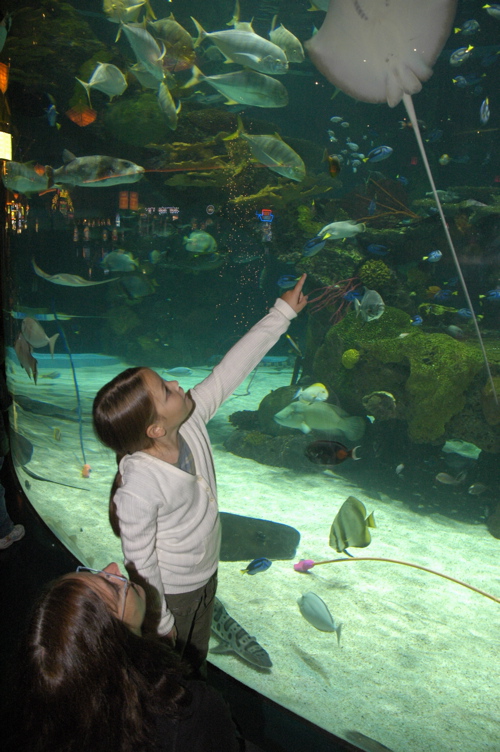
Now, we’ve all seen the mammoth Bass Pro Shops, but of course the Las Vegas one has to be bigger and better than all the rest. The one we visited featured an enormous salt water aquarium, in addition to a casino, a bowling alley made to look like a very long Airstream, and a hotel. It’s all free to roam, which reminds me that there are a lot of great things to see and do in Las Vegas that won’t break the bank.
The Airstream bowling alley is only two lanes and kids aren’t allowed inside. But it turns out we all like bowling so we headed over to a different casino with about 70 lanes. (There doesn’t seem to be any bowling in Las Vegas that isn’t attached to a casino.)
At sunset we went to the Ethel M Chocolate Factory and Cactus Gardens. (That’s the weirdest combo since the Hawaiian Nuts and Ukulele Company last week.) At Christmas time the cacti are covered in colored lights and the effect is ethereal, even spooky. This gives me ideas for our future Christmases in the desert. A saguaro in the backyard makes a very interesting Christmas tree.
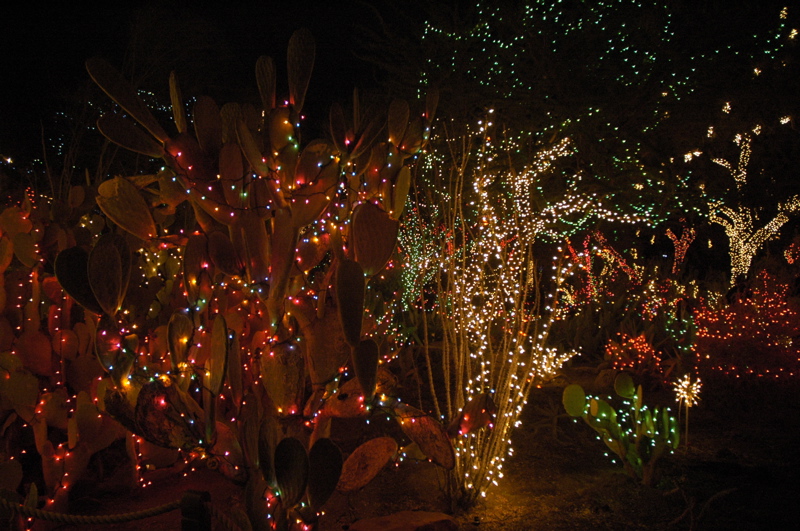
Then of course we had to take the chocolate factory tour (free & quite brief), and ended up in the chocolate store. So some people we know are going to get some very nice chocolates for Christmas.
We really have to leave Las Vegas now, or at least the driveway. We still haven’t been kicked out officially, but our holding tank is full. I think that’s a sign we’ve taken sufficient advantage of the hospitality. We’ll hit the road in the morning, due south, and see what’s interesting between here and Mexico.
December 8, 2007 at 5:42 pm · Filed under Maintenance, Mobile technology
I’ve over-used my camera and it needs a rest. Some time ago I calculated that I shoot roughly 12,000 photos a year. The trusty Nikon D70 that I have been using for about three years has put up with immense stress, including everything from being dumped in Florida sand to being splattered in the Washington rain forest.
The camera has done well, but the toll of years, miles, and images has begun to show. The onboard flash stopped working a year ago, the long 55-200 zoom makes a grinding noise from the sand inside it, and now my primary lens has a spot in it.
If you look at the photo of “The Mad Greek” I posted a few days ago, you will see the problem. In the upper middle of the image there is a unfocused dark spot. This has actually been in all my photos for the past week or so, but in some images it is hard to see. The spot appeared while we were in Hawaii, sometime between the USS Arizona Memorial and Hanauma Bay. It’s probably some dust that got inside the lens.
In a way, it’s a souvenir of Hawaii, perhaps some lava. I hope Pele the volcano goddess doesn’t blame me. She doesn’t like it when you take lava from the islands.
I was able to work around the other problems, but this one is a killer. The lens probably has to be disassembled, and in the meantime I’ll be camera-less, which for me is like having a thumb removed. My friend Bert Gildart, a serious professional photographer, advised me to get not only another lens but a second camera body, so the D70 could be retired to the role of spare.
(Bert can be forgiven for his free-spending advice. He is currently blissed out, rolling around in joy like a pig in slop, because he just got his new Nikon D300, which is an amazing new camera. The D300 costs $1800 without any lenses and it is not in my budget.)
I have discovered that getting a hard drive replaced on a laptop is much easier than getting camera service. My options are few: ship the camera to an authorized service center, or find a local camera repair shop (very rare) in a major city. Either way, the camera is out of commission for days.
So Bert’s advice does make some sense. A couple dozen of my photos have appeared in Airstream Life, and hundreds are on this blog, making the camera a clear business expense (ahem), and potentially justifying spending a bit more. I’m looking at a really slick replacement lens that would lighten my camera bag and greatly reduce the need to switch lenses when working: the Nikon 18-200mm VR zoom. Unfortunately it is not exactly cheap either, at about $700 from reputable dealers. I’d ask Santa but I already got a ukulele.
Despite the maintenance now needed, the Nikon has been almost as tough as our Airstream. The Airstream has over 50,000 miles on it and with a good bath it will look almost new. It still performs like new and there’s every reason to expect it will last for decades. I can only hope the Nikon lasts as long. I like equipment that can take a beating and doesn’t wear out prematurely. Traveling as we do, there’s no advantage in buying cheap stuff that doesn’t last.
We are still in Las Vegas because Brian and Leigh won’t let us leave. No, really, it’s because they keep emphasizing that we are welcome to stay longer and that’s awfully convenient right now. We have nowhere to go for a while, Eleanor can do her shopping easily here, Emma can recuperate, and I’ve been finalizing articles for the Spring 2008 issue of the magazine.
Plus, Brian and Leigh are giving me lots of “black socks” ideas that may get integrated into our upcoming new website launch. Airstream Life magazine will have an exciting (I hope) new website in a few weeks with a lot more content for you. Our staff of programming gnomes have been hard at work on it for weeks, and I’m really pleased with the way it is shaping up. Airstreamlife.com should soon be a very interesting destination …
December 7, 2007 at 10:01 pm · Filed under Travel / lifestyle musings
Some of the most interesting people we meet are fellow bloggers as well as fellow travelers. Brian and Leigh are a great example. Although they aren’t on the road presently, they did nearly two years in a 1963 Airstream Flying Cloud, working the whole time, just like us. Although we never crossed paths while they were traveling, the commonalities of our experiences are amazing. We’ve had the same challenges, the same questions, the same answers.
This evening we were hanging around the kitchen with mugs of tea after dinner, and inevitably the talk turned to things that happened in the trailer. We’ve both had the spice rack explode onto the floor while towing, and the concerned friends who advised us against doing what we were doing. We’ve both faced the challenges of living with others in a small space, and survived that acid test of a relationship.
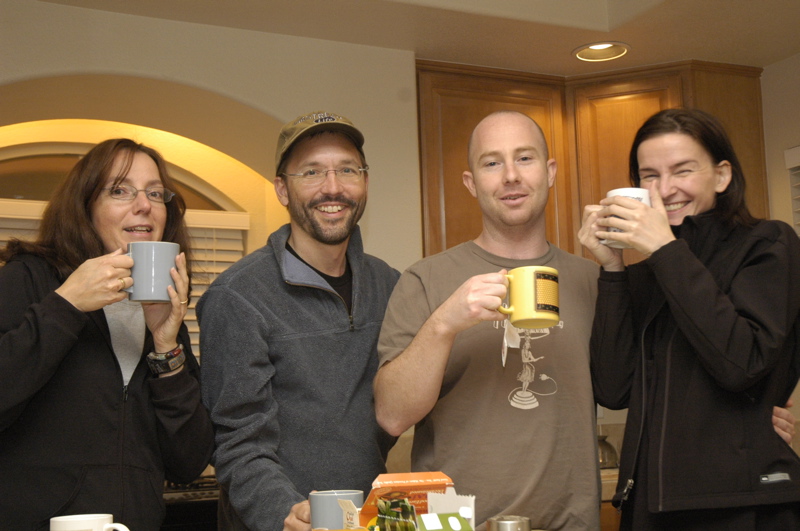
Photo by Emma
But still I am surprised by the little things. At one point, Leigh pointed to her black socks and Brian’s black socks. When they went out on the road for the first time, they bought 28 pair of identical black socks so that laundry would be easier. No worries about whose were whose, or which pairs matched up. Her size 6 feet and his size 8 were close enough for shared socks. That’s a great idea that never occurred to us.
For the past three days I’ve been working in Brian and Leigh’s office with them. All three of us are very busy at our tasks, and yet it was no big deal to share an office. Being roommates, and negotiating space, and working with others comes very naturally to someone who has lived in an RV for a couple of years. It was almost instinct. We got a lot of work done and yet still had time for a 2 p.m. “poker break” yesterday. (By the way, we haven’t been playing for money, just chips.)
This experience reminds me how ironic it is that so many companies that are phobic about their employees working outside of the office, even when it saves money for the company. Many of us have proven that working at home or even on the road not only works, but it can increase productivity and satisfaction. It is even possible that living the RV lifestyle helps people learn good self-motivation, time management, and organizational skills. Yet so many people still feel that all of their employees need to be sitting in a cubicle in an office building … even when they have no real need to be there.
As this attitude changes, there will be more opportunities for people to work and travel at the same time. That means more opportunities to exchange ideas, think creatively, and find new talent. That’s how I use my working days on the road, and it has paid off many times over. “Black socks” are just a tiny example of the dozens of great ideas I’ve picked up along the way.
Airstream Life magazine would never be nearly as good if I was not out here in the world, meeting new people and hearing their ideas. Although we are a “virtual company” (meaning we have no office space or permanent physical location), it is still critical to regularly interact with people on a one-to-one basis. This binds relationships, promotes brainstorming, gives me new perspectives, and brings me in physical contact with the lifestyle. After my laptop computer, the Airstream is the most critical business tool I have. The collection of “black sock” ideas I have implemented in the business during the past two years is the proof.
December 6, 2007 at 6:59 pm · Filed under FAQs
Probably the most common problem I see among RV’ers is the inability to back up their trailer. We meet tons of people who camp only where they can find a “pull thru”, and will go to great lengths to avoid ever getting into a situation where they might have to back up. We usually encourage them to give it a try, but I don’t think our advice has ever been accepted.
Even among people who do back up once in a while, it can be challenging. Single-axle trailers back up differently from double-axle trailers, and longer ones are different from shorter ones. The type of hitch you have can make a small difference too. Backing up requires you to have a sense of how the trailer will react to various inputs from the tow vehicle, while simultaneously watching for signals from your assistant, and checking for obstacles in three dimensions. It can be very challenging.
We’ve been lucky enough that in all our travels we have never dinged the trailer during backing, but that’s rare. Most everyone has a scrape or dent somewhere to point to, showing the time they nudged a picnic table or didn’t see that low tree branch. It’s easy to dent the soft aluminum of an Airstream and not even know it’s happening.
But learning how to back up is a great reward. Often we come to campgrounds where we are offered a pull-thru site or a back-in site for a few dollars less. We always take the back-in and save the money. I figure it’s payback for all the practice.
My blog post yesterday got a few comments from people admiring the backing-in job we did here at Brian and Leigh’s. It was one of those great moments when, under the pressure of witnesses standing by, we just swung it in there in a single pass and ended up exactly where we wanted to be, inches from a concrete block wall and a house. Blog reader Dirk asked if I had tips for others, or if this particular backup was a “breakthrough moment.” Actually, I hadn’t thought any further about it until we got the first blog comment this morning. It was just another parking job to us, but remember that we’ve been in our Airstream over eight hundred days. In all that time, I’ve gotten plenty of practice — and practice is the real secret.
I suppose there are a few other tips to share. The most important is to have a partner to help if possible. You could call him/her your “backing buddy”. Typically this is your spouse. You can’t see very well behind your trailer, and it’s easy to overlook obstacles. Your partner stands near or behind the rear rib of the trailer, well off to the side, and directs you in. Tell your partner that if she can’t see your face in the side mirror, you can’t see her either. The partner should stand on the inside of the turn, and in some places this means she has to tell you to stop so she can move to the other side.
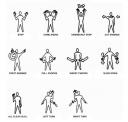 Lots of people use walkie-talkies but we just use hand signals like those used at the airport. Make sure you both know the proper signals and don’t spontaneously make up new ones. The signals should use your full arms, not just hands, so the driver can see them clearly. You only need four signals: left turn, right turn, come ahead, and stop. For stop, we use crossed forearms (forming an X) because they are easier to see. You might also want a fifth signal, “go ahead,” when the backing isn’t going well and you need to pull forward again.
Lots of people use walkie-talkies but we just use hand signals like those used at the airport. Make sure you both know the proper signals and don’t spontaneously make up new ones. The signals should use your full arms, not just hands, so the driver can see them clearly. You only need four signals: left turn, right turn, come ahead, and stop. For stop, we use crossed forearms (forming an X) because they are easier to see. You might also want a fifth signal, “go ahead,” when the backing isn’t going well and you need to pull forward again.
The nice thing about hand signals is that they impress the hell out of people who watch us. They look very professional and it helps scare off people who like to “help” you back in.
I have only one tip regarding “help” from strangers. DON’T ACCEPT IT unless you really have to. If you have a partner, use the partner who you are accustomed to and can trust. Most people are well-meaning but since you don’t know them, you really don’t know if they are going to back you into a tree or confuse you with misleading advice. My friend Rich Charpentier has two dents on his Airstream, both courtesy of people who (on different occasions) tried to help him back into campsites. Not surprisingly, none of those people offered to pay for the damage that resulted from their bad advice.
Once in a while we have managed to insult people (unintentionally) who had a serious desire to “help” us back in. I remember a particular time when someone wouldn’t accept my standard reply of “No thanks, I have Eleanor to help me and we’re used to working together.” He continued to direct me aggressively and loudly toward an overhanging branch while I ignored him and followed Eleanor’s advice. When the parking was done, he was miffed, but we got to know each other the next day and eventually became friendly.
There’s a popular technique taught to newbie trailer owners: put your hand on the bottom of the steering wheel and turn it in the direction you want the trailer to go. This tip plays a part in the 1950s Lucy & Desi movie called “The Long Long Trailer,” when Desi Arnaz is being shouted at by dozens of well-meaning relatives while he backs down a long driveway. The technique works when there aren’t a lot of relatives around, but I don’t do it. Find a technique that works for you and stick with it.
Backing up is best done slowly. Don’t let anyone rush you, not even traffic you might be blocking. They can wait. Going slowly allows you to learn how the trailer is responding, and it gives you partner a chance to check clearances as you go. Remember to have the backing buddy check above and below the trailer as you go. Overhanging tree limbs and curbs will sneak up on you if you aren’t careful.
Finally, don’t back up at night until you are well-practiced in daytime. Even then, go extra slowly at night and check your clearances multiple times. You’ll need good flashlights too, because the backup buddy will be invisible. At dusk, like when we arrived here at Leigh and Brian’s house, I’ll get out of the truck three or four times during the backing process, to check my progress and confer with Eleanor. Even after hundreds of backing operations, we’re not immune to the possibility of running into something.
In fact, we’re far from perfect backers. Many times I’ll get the “go forward” signal from Eleanor and have to try again, sometimes three or four times. The keys are to stay calm, don’t fight, and go slowly. You’ll get in there eventually.
December 5, 2007 at 10:01 pm · Filed under Uncategorized
We are comfortably settled next to Brian and Leigh’s house. They’ve been making comments about how the Airstream looks like it belongs here … and since they are currently Airstream-less, this sounds very dangerous. The trailer does fit nicely next to the driveway. I know they are thinking about getting back on the road in the next two years. Will we cause them to accelerate their plans? I’d like to think so.
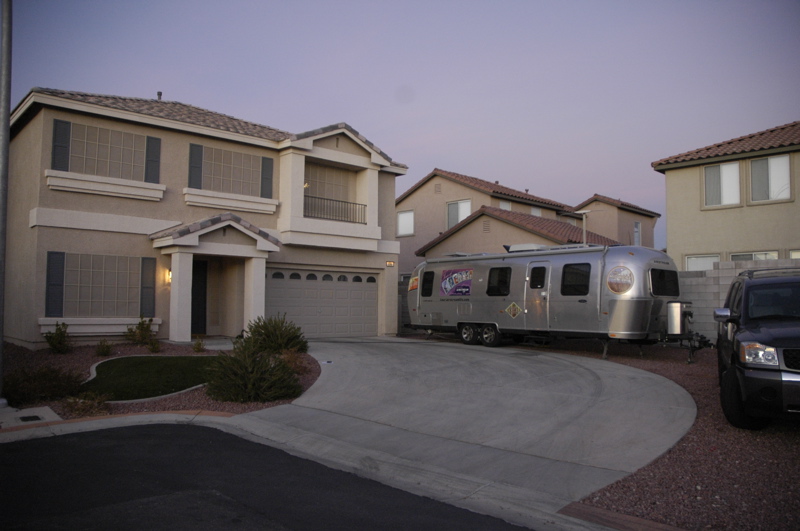
Emma has been struck down by a cold, probably the result of flying five hours across the Pacific just a couple of seats away from a couple that were sneezing. This is one of the things we really hate about flying. It seems like one of us always catches a cold after a flight. That’s one of the reasons I try especially hard to avoid flying in the winter. Emma has spent the day resting, reading, drinking fluids and eating Clementines, with occasional breaks to toss a ball for Curtis the dog. She was slated to do home schooling all day but we gave her the day off.
However, it was no day off for me. I set up in Brian and Leigh’s home office, and the three of us just put our heads down and worked all day. At the end of the day, they took a poker break and taught me a few things about the game.

Anyone who follows their blog knows that Leigh and Brian are consummate poker players. They are the kind of players I like, not flashy, but very consistent. They play an intellectual game, studying the nuances, and they work at it. As a result, they are very good. I felt privileged to play with them for an hour.
We’ve got much more work to do this week, so we’ll stay parked in the driveway at least one more night. There’s no rush to go especially now that Emma is a bit down, and I can certainly make us of the work time. If there’s extra time this week, and Emma is feeling better, we’ll try the Children’s Museum and maybe visit the 4-D “Polar Express” ride at the Excalibur.
« Previous entries ·
Next entries »








